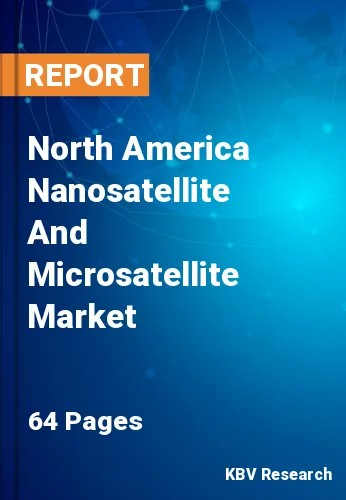The North America Nanosatellite And Microsatellite Market would witness market growth of 21.0% CAGR during the forecast period (2022-2028).
An artificial spacecraft with a wet mass between one and ten kilograms is referred to as a nanosatellite or nanosat. The terms satellite swarm and fractionated spacecraft may occasionally be used to describe designs and planned designs of this type. They may be launched alone or they may include numerous nanosatellites operating together or in formation.
A typical type of nanosatellite, known as a CubeSat, is a cube-shaped satellite with a mass of fewer than 1.33 kilograms per unit and dimensions of 10 x 10 x 10 cubic cm. The specifications of CubeSat, for use by any enterprise wishing to launch a nanosatellite, are managed by the team that first developed the CubeSat concept at California Polytechnic State University and Stanford University.
The implementation of small satellites has lowered the barrier to entry into space, allowing these enterprises and previously non-spacefaring nations to make progress toward establishing a foothold in low-Earth orbit. CubeSats have become an entry point for nations taking their initial steps beyond Earth, with the space station playing a crucial role in this development.
North America's supremacy in space activities pertaining to smallsats is attributable to the introduction of the CubeSat Launch Initiative (CSLI). According to data sets given by the U.S. government, the region is likewise anticipated to be the region with the quickest growth. NASA EDSN, SeeMe and ALASA payloads, NSF Geospace & Atmospheric CubeSat, F6, NRO Colony I & II, and QB50 are the primary nanosatellite and microsatellite programs for the foreseeable future from this region.
The US market dominated the North America Nanosatellite And Microsatellite Market by Country in 2021, and would continue to be a dominant market till 2028; thereby, achieving a market value of $2,382.2 million by 2028.The Canada market is poised to grow at a CAGR of 23.8% during (2022 - 2028). Additionally, The Mexico market would witness a CAGR of 22.7% during (2022 - 2028).
Based on End-Use, the market is segmented into Commercial, Government, Defense & Security and Civil. Based on Application, the market is segmented into Earth Observation/Remote Sensing, Communication & Navigation, Scientific Research and Technology & Academic Training. Based on Mass, the market is segmented into Nanosatellites and Microsatellites. Based on countries, the market is segmented into U.S., Mexico, Canada, and Rest of North America.
Free Valuable Insights: The Global Nanosatellite And Microsatellite Market is Predict to reach $8 Billion by 2028, at a CAGR of 22.3%
The market research report covers the analysis of key stake holders of the market. Key companies profiled in the report include Dauria Aerospace, GomSpace Group AB, ISISPACE Group, Sierra Nevada Corporation (SNC), Spire Global, Inc., AAC Clyde Space, Surrey Satellite Technology Limited (SSTL), The Boeing Company, and Tyvak International
By End-Use
By Application
By Mass
By Country
Our team of dedicated experts can provide you with attractive expansion opportunities for your business.

